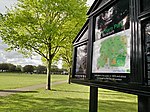Upton House, Newham
British country houses destroyed in the 20th centuryFormer buildings and structures in the London Borough of NewhamLondon building and structure stubs

Upton House was a building in West Ham, Essex (now the London Borough of Newham) on what is now the corner of Lancaster Road and Upton Lane In 1827 it was the birthplace of the surgeon Joseph Lister. In 1893 a temporary church for St Peter's Church, Upton Cross was set up in its gardens, with the house forming the vicarage - the permanent church was later built in the gardens. The vicarage was demolished in 1967-1968 and its site is now occupied by Joseph Lister Court.
Excerpt from the Wikipedia article Upton House, Newham (License: CC BY-SA 3.0, Authors, Images).Upton House, Newham
Upton Lane, London Upton (London Borough of Newham)
Geographical coordinates (GPS) Address Nearby Places Show on map
Geographical coordinates (GPS)
| Latitude | Longitude |
|---|---|
| N 51.5395 ° | E 0.0232 ° |
Address
Upton Lane 293
E7 9PS London, Upton (London Borough of Newham)
England, United Kingdom
Open on Google Maps





